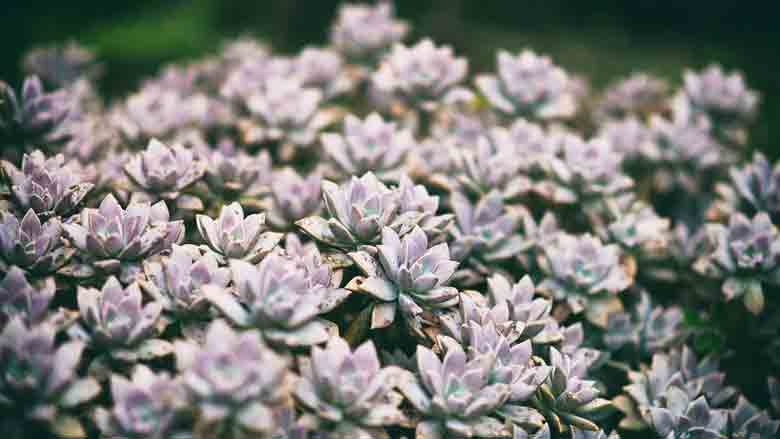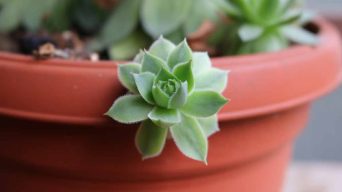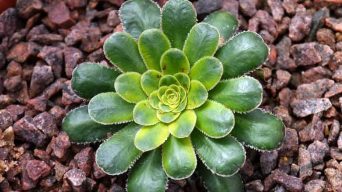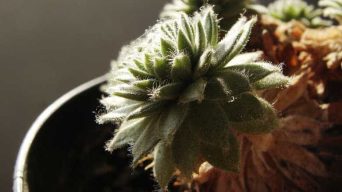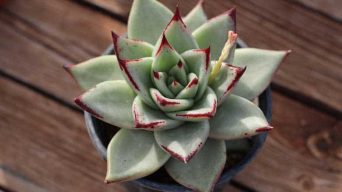Succulents are plants that grow easily, with minimal care. There are many different types of succulents, and they come in a variety of forms.
They do not require much water or fertilizer to thrive, making them perfect for those with little time to care for their plants.
Succulents will grow at varying rates depending on the type and how it is cared for.
In this article, we’ll explore how fast do succulents grow and give some tips on how to make them grow faster!
How Long Do Succulents Take To Grow
Succulents, in general, are slow growers. However, certain varieties grow more slowly than others. It may take anywhere from three to four months to see any growth in succulents.
Some succulents, such as Haworthia and Gasteria, grow smaller and slower. Kalanchoe or Echeveria, on the other hand, may grow considerably faster.
The initial year is critical. A slow grower like a Haworthia may take a year or more to mature.
Echeveria succulent type, for example, can grow up to 6 to 8 inches in height in a single year from a 2-inch seed when slow growers like Haworthia plants require years to reach that size.
Fast-Growing Succulents
There are a few succulents that grow more quickly than others.
Some of the most common fast-growing succulents are:
- Aeonium Sunburst
- Agave attenuata
- Aloe Vera
- Calandrinia grandiflora
- Christmas Cactus
- Crassula Sarmentosa
- Echeveria elegans
- Euphorbia canariensis
- Kalanchoe daigremontiana
- Sedum spurium
Slow-Growing Succulents
There are also a few succulents that grow more slowly than others.
Some of the most common slow-growing succulent plants are:
- Agave parrasana
- Agave shawii
- Ariocarpus scaphirostris
- Carnegiea gigantea (Saguaro)
- Crassula marnieriana
- Cyphostemma juttae
- Gasteria armstrongii
- Haworthia mirabilis
- Haworthiopsis tessellata
- Opuntia macrocentra
How To Make Succulents Grow Faster
The best way to make your succulents grow faster is by providing the right growing conditions.
Succulents require proper care to grow quickly.
There are a few things that you can do to make your succulents grow faster:
Use the Right Type of Soil
Succulents prefer fast-draining soil. A cactus soil mix is ideal, but any potting mix designed for cacti or succulents will be suitable.
Soil preparation is important to keep in mind when planting your succulents because you do not want the soil to stay wet and become waterlogged.
This can cause rot and kill off your beautiful plants!
A good succulent soil mix will have more sand and less potting soil.
You should be able to tell the difference just by looking at it! Potting soil is dark brown or black, while succulent soil will look much lighter in color with a coarse, grainy texture.
Succulents can grow well in a regular houseplant potting mix as long as you add perlite or pumice to the mixture (equal parts of each) before planting. This will improve drainage and reduce water retention for your plants.
Succulents grown outdoors prefer sandy loam-rich soils, which drain quickly after rain but hold enough moisture during dry periods.
Provide Enough Sunlight
Succulents need at least six hours of sunlight throughout the day. If they do not receive enough, their growth rate will be slower than usual and may cause them to wilt or die.
When grown indoors, succulents should be placed near a window that has sunlight streaming in.
Avoid windows that get full sun because the heat may damage their leaves. A window with western or eastern exposure is best because succulents can get a lot of sunlight throughout the day.
When grown outdoors, succulents need to be placed in a spot where they will receive at least six hours of sunlight throughout the day.
A southern exposure is ideal because it provides more sunshine than any other area on your property. But depending on how close you live to the equator and how overcast or cloudy the days are during certain seasons, this may not always be possible.
To get around that problem, grow them under trees by planting them off to one side rather than directly below so that they can still receive filtered sunlight for most of each day.
Succulents also prefer growing alongside shrubs instead of grasses because grasses tend to shade their leaves too much and prevent proper photosynthesis from occurring.
If you do not have enough room in your yard to plant succulents near a tree or shrub, you can install trellises on the side of your house and grow them above ground.
To ensure there are at least six hours of sunlight each day, take advantage of long summer days by growing them outdoors for part of the year and bringing them inside when it gets colder outside.
This way, they will receive more sun than they would if you kept them indoors all year long.
Provide Adequate Watering
Succulents need to be watered thoroughly but infrequently.
This is because they store water in their leaves and stems to use during periods of drought.
Therefore, watering them too frequently can cause them to rot from the inside out.
To ensure that your succulents receive enough water without overwatering them, wait until their soil begins to feel dry before you thoroughly soak it.
To check, stick your finger in the soil and see if it is moist or dry.
If you cannot easily make out what the condition of the dirt looks like with just your eyes, use a chopstick to dig around in there instead. It will be able to tell how wet or dry the soil is without disturbing them too much.
When you water your succulents, pour the water slowly right around their base so that it penetrates deep into the soil.
You do not need to dump a bunch of excess water all over them and let the tray underneath collect any runoff for later use on other plants or during another watering cycle.
Choose the Right Pot
Succulents need to be planted in the right kind of pot as well.
Mixing and matching different species into one planter can cause several problems, such as creating an environment too humid for some plants or not having enough nutrients available for others.
To avoid these issues, choose pots that are large enough to grow into but small enough to handle them easily.
Succulents need at least six inches of space around their base, so choose a pot with those measurements and do not cram too many plants in one container together.
The best type of pot to use is one that has a drainage hole in the bottom.
Succulents need to drain out any excess water they receive, and if the pot does not have this feature, you could end up with mold or root rot from overwatering them.
Be sure to choose pots made of porous materials like terra cotta or concrete instead of plastic, glazed ceramic, or metal because these types tend to hold on to water and humidity.
Once you have chosen a pot for your succulents that is the right size with at least one drainage hole in the bottom, fill it about halfway with soil before planting.
This will give them room to grow without becoming root-bound.
Use Fertilizer Very Sparingly
Succulents don’t need a lot of water or food, so use fertilizer very sparingly. Only give them diluted liquid organic plant food once every few weeks during the growing season.
Fertilizer is only needed for plants that are actively growing and need food to grow faster or get larger leaves.
Fertilizer is not good to use during the winter because plants are dormant. But if your soil does not have any nutrients, it can be helpful to use some organic liquid plant food.
Over-fertilizing succulents is one of the most common mistakes in growing them. It can result in weak, soft leggy growth, which will never do well. So be sparing with any plant food you give them.
Prune When Necessary
Succulents don’t need a lot of pruning, but they can benefit from a little.
If you have some dead growth or leaves that are broken, back or damaged in any way, it is best to remove them because this will allow new healthy leaves and branches room to grow more quickly.
If your succulent plant has long brown stems with no buds coming, then these should also be removed to promote healthy new growth.
If you want your succulents to grow quickly, then pruning them and removing dead leaves, branches or stems is the best way to do it.
Repot the Plant When Necessary
Succulents don’t have to be repotted often, but when you need to repot them, you must do so in fresh soil.
If your succulent has roots coming out the bottom of its pot, then this means it needs to be repotted because there’s not enough room for more roots inside the pot.
When repotting a succulent, make sure you use soil that drains well and is made for cacti or succulents because regular garden soils don’t drain quickly enough and can lead to root rot.
If the plant becomes too large for its pot, it will need repotting into something larger.
But if your plant is already in its largest pot and grows a lot during the summer, you can give it some fresh soil so that new roots have room to grow.
Take Care of Pests and Diseases
Something that can stunt the growth of succulents are pests and diseases.
When you purchase your succulents, make sure to inspect them for any pests or diseases. If there are signs that the plants have been affected by pests or diseases, do not buy them because it will just spread the problem in your garden.
To keep bugs at bay (harmful bugs), rinse off all leaves and debris before bringing new plants into the house.
This is a critical step when planting succulents indoors so they don’t get infested with bugs like spider mites, which can harm healthy growth.
Catching a potential bug early on is beneficial as well. Going around regularly inspecting your plant pots should be done every week or two until everything looks clean and clear again.
Diseases can also be harmful, but it is more difficult to spot them in the beginning.
If you notice some sort of wilt on your plant, this could mean that there’s a disease going around and destroying succulents left and right.
Again, inspect plants regularly for signs of diseases because once they take hold of one plant, it will spread like wildfire through all other plants nearby.
It’s critical to detect any pest or disease as soon as possible to prevent succulents from infestation and sickness, which can have a negative impact on their growth.
Keep Succulents Cool in the Summer
When summertime comes around, it’s important to keep succulents cool because when they sit in hot conditions for too long, their growth can be stunted.
It is recommended that you bring your plants indoors if the weather becomes unbearably extreme and try to keep them where there isn’t any direct sunlight hitting them, as this can damage their growth.
If you live in a hot and dry climate, it’s best to plant succulents where there is some shade provided by the large trees around you or another structure.
This will help protect them from getting too hot and drying out, which is critical for their growth.
Keep Succulents Warm in the Winter
It is essential to keep succulents warm in the wintertime so they don’t get too cold or frostbitten.
It can be a good practice to bring plants inside for protection during times of an early freeze because once their leaves become damaged from freezing over and breaking off, that’s when you know there has been severe damage done.
Once plants have been exposed to a freeze, it’s advised that you cut out the damaged parts of leaves and stems so they don’t rot or spread disease throughout your other succulents nearby.
If you live in a colder climate, it is best to plant succulents that are not directly exposed to harsh elements like snowfall or heavy winds.
Planting them next to walls of houses and underneath trees can provide some much-needed shelter from harsh winter weather conditions that could potentially damage their growth process.
Final Thoughts
Succulents are great plants to grow but need regular maintenance to reach their full potential.
When it comes to growing succulents successfully, the most important thing is that they are cared for properly and have the proper environment to thrive and prosper.
Regularly inspecting plants, providing them shade, keeping them cool during hot weather conditions, and being warm in cold weather is critical for their health to grow strong and healthy without any problems or issues.

